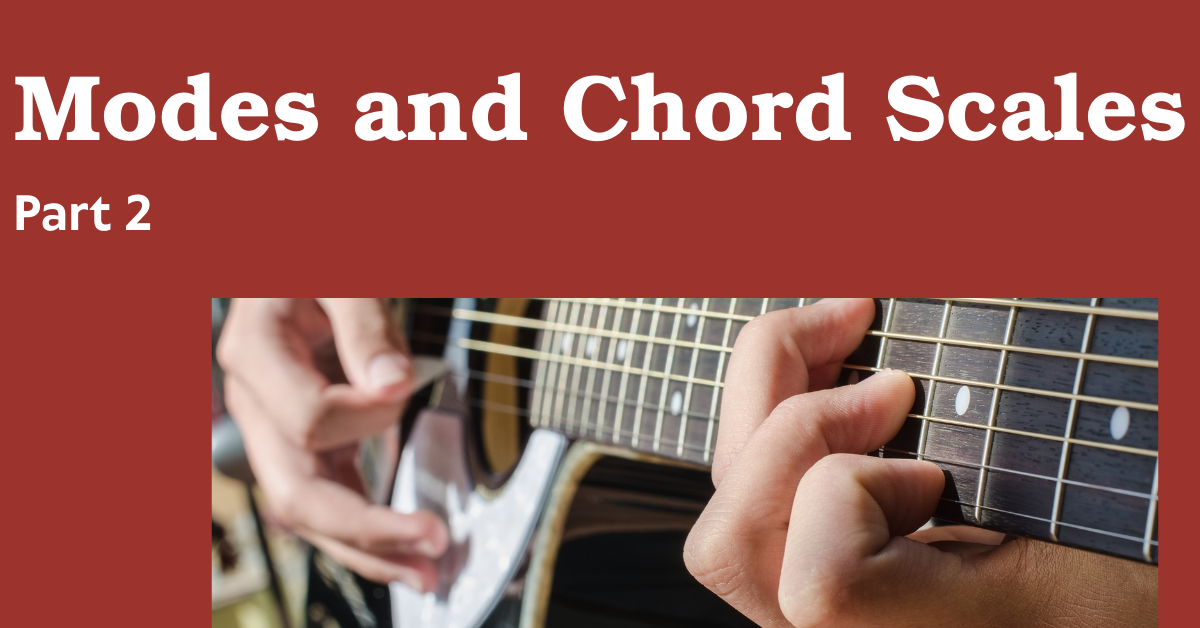Modes and Chord Scales (Part 2)

Now that we have learned to identify the various modes of the major scale, let's turn our attention to how we would use this information in a real-life musical situation. Take a look at the chord progression below:
What information can you deduce simply by looking at these two measures of music? A few things, actually. First, it's important to notice that this is a lead sheet or fakebook style of music, meaning there is no bass clef. That means that the pianist is being asked to "comp" (play chords rhythmically in time with the music) through these measures. Second, there is no time signature, however the "rhythm slashes" indicate that there are 4 beats per measure, so you can infer a 4/4 time signature. And lastly - and most importantly - this is a "ii - V - I" progression, which tells us that this music is in the key of D major (at least temporarily).
Noticing the "ii - V - I" progression is the key to going further in our discussion regarding modes and chord scales. These Roman numerals are what musicians use to indicate harmonic analysis. What is 'harmonic analysis'? It's just a fancy way of saying "the study of the chords and how they move from one to the next." We use upper-case Roman numerals when the chords are major or dominant, lower-case when the chords are minor or diminished. In the chord progression above, we are talking about three chords, all of which are diatonic to the key of D major (for more information about diatonic chords and Roman numeral analysis, check out this great video lesson which explains these concepts in greater detail).
In a nutshell, we use the Roman numerals to identify a chord's placement in a particular scale (Are you noticing how we're starting to merge this idea of chords + scales = chord scales? I thought you might be impressed). Anyway... Each note in a scale is referred to as a degree of the scale. The first note (D) is the 1st degree, the second note (E) is the 2nd degree, etc. If we are in the key of D major and stack thirds onto each degree of the scale we would get the following:
These are referred to as diatonic chords. Next, we give each chord a Roman numeral name based on its order within the scale (using upper- or lower-case depending on whether the chord is major, minor, etc).
So now you can see that, in the key of D major, a "ii - V - I" progression like the one we have above is simply a shorthand way of saying "Emin7, A7, Dmaj7."
But why all the hullabaloo about the chords and the Roman numerals? Well, because just as the chords have a particular placement within the scale, so too do the corresponding chord scales.
Think about it this way: the "ii" chord in the key of D major is "E minor 7." Now ask yourself, "What is the mode that is built off the 2nd scale degree in the key of D major?" The answer is "E dorian." You can see the obvious relationship between "ii" (the chord) and "2" (the scale degree), so now we're going one step further and asking "What is the mode that is built upon the second scale degree?" Since E dorian is the mode that is built on the 2nd scale degree of D major, we can say that it is the chord scale that corresponds to the E minor 7 chord. It therefore follows that "A mixolydian" is the chord scale that corresponds to A7, and "D ionian" (or D major) corresponds to the Dmaj7 chord.
Harmonic analysis is the language of jazz musicians, composers, arrangers, orchestrators, and educators. Explore these concepts to gain a better understanding of these terms and the music that you're playing!



